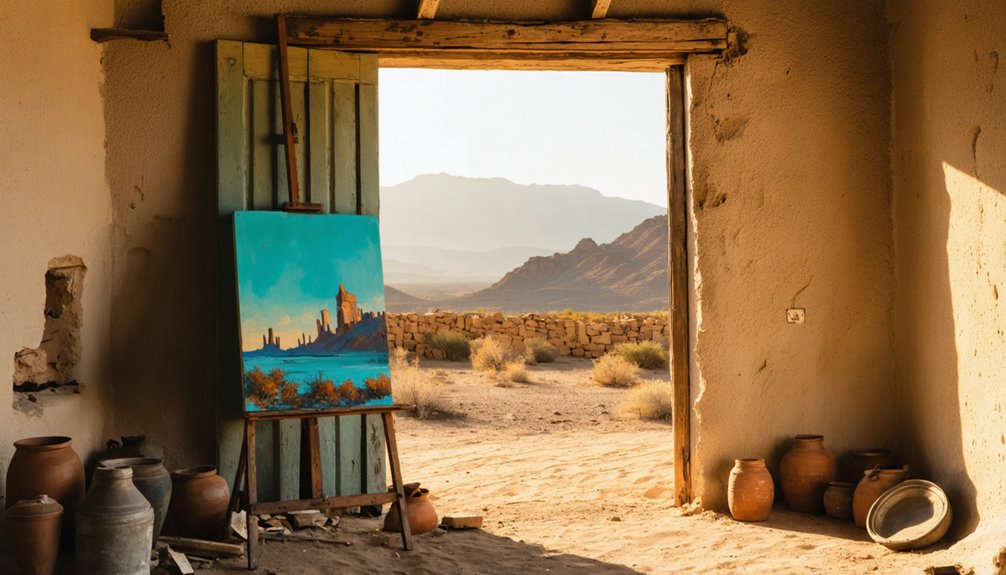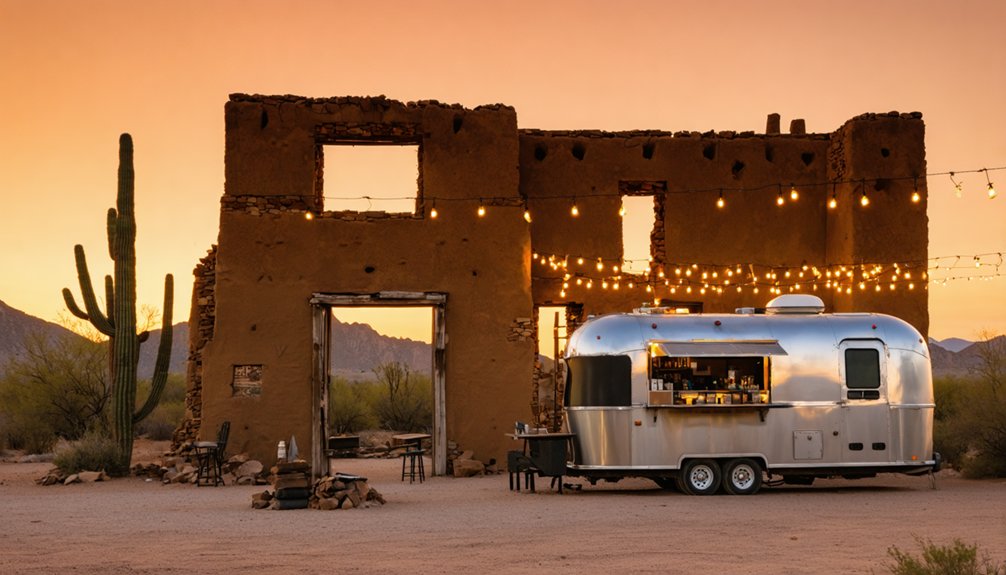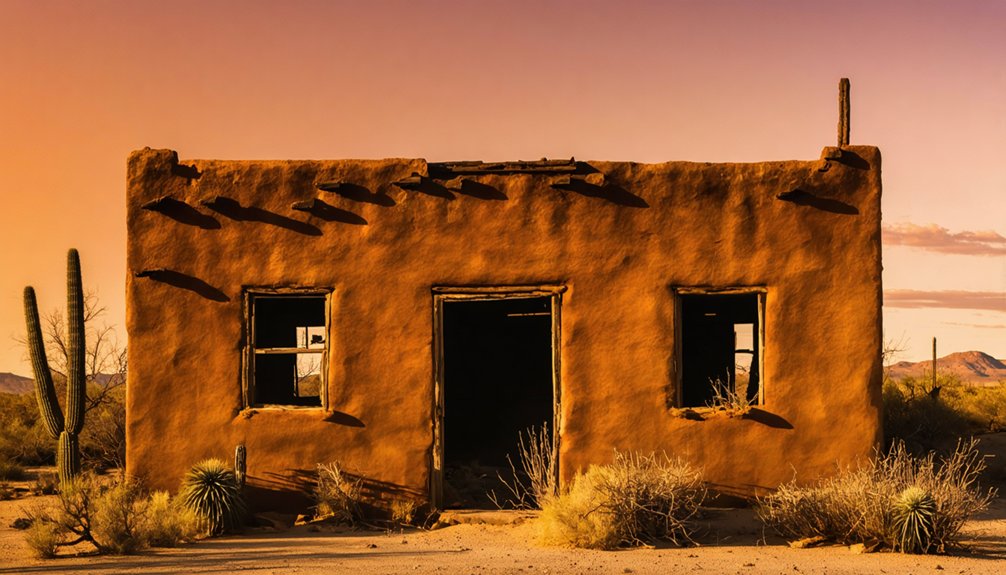You’ll discover Terlingua ghost town in Texas’s Chihuahuan Desert, where mercury mining boomed from 1880 to 1940. The Chisos Mining Company transformed this remote outpost into Texas’s largest mercury producer, with a population reaching 2,000 during peak operations. After the mine’s closure, most residents abandoned the town, leaving behind haunting ruins of the company store, worker housing, and cemetery. Today, artists and adventurers have revitalized Terlingua’s desert spirit into something uniquely their own.
Key Takeaways
- Terlingua transformed from a thriving mercury mining town of 2,000 residents to a ghost town after the industry’s collapse following World War II.
- Historic ruins include abandoned mercury mines, the Chisos Mining Company store, weathered structures, and the iconic Terlingua Cemetery.
- The town’s remains reflect strict social segregation, with separate areas for Mexican laborers and Anglo workers during its mining heyday.
- Modern Terlingua has evolved into an artistic community, hosting annual events like chili cook-offs while preserving its ghost town character.
- Located near Big Bend National Park, Terlingua attracts visitors with its rich mining history, desert landscape, and exceptional stargazing opportunities.
The Origins of a Desert Mining Town
Before Terlingua became a mercury mining boomtown, this remote Texas desert region was home to Apache tribes and Mexican villagers who settled along Terlingua Creek near the Rio Grande.
The area’s cultural heritage stretches back to Native Americans who used cinnabar’s red pigment in their pictographs, leaving traces of the region’s earliest historical preservation.
Ancient indigenous artisans preserved their history through cinnabar-pigmented pictographs, leaving enduring cultural footprints in Terlingua’s desert landscape.
You’ll find the town’s transformation began in the mid-1880s when prospectors discovered rich cinnabar deposits. A local post office was established in 1899 to serve the growing community.
Jack Dawson kick-started industrial mercury production around 1888, and by 1900, multiple mining operations were extracting significant quantities.
The settlement, initially called Marfa and Mariposa, eventually became known as Terlingua – possibly derived from “Tres Lenguas” meaning “three tongues” in Spanish, reflecting the area’s mining or geographical features.
The town grew rapidly from its humble beginnings, reaching a population of 200 to 300 laborers by 1902.
Mercury Mining’s Rise and Fall
As mercury mining took hold in Terlingua during the early 1900s, the Chisos Mining Company emerged as the region’s dominant producer under Howard E. Perry’s leadership.
From 1919 to 1941, Chisos Mining Company produced 39,094 flasks of mercury, making it the largest producer in Texas.
Workers extracted cinnabar ore from deep mine shafts, transporting the heavy rocks by hand and pack animals to processing facilities.
You’ll find that mercury extraction reached its peak during World War I when demand for explosives soared and European supplies were disrupted.
The mining legacy, however, came at a devastating human cost. Mexican immigrant workers faced deadly working conditions, with mercury poisoning drastically shortening their lives to their 30s or 40s.
The town’s cemetery stands as a sobering indication of these losses. While Terlingua’s population swelled to 2,000 during the boom years, the industry’s fate was sealed by the 1929 crash and Great Depression.
Despite revival attempts in the 1960s and early 1970s, including Diamond Shamrock’s new processing facilities, the last mercury production occurred in 1973.
Life in the Company Town
If you lived in early 1900s Terlingua, you’d find your daily life centered around the Chisos Mining Company’s mercury mines and company store, where you’d purchase necessities with company scrip.
Your housing assignment would reflect the town’s strict segregation, with Mexican laborers living east of the commissary and Anglo workers settling to the west.
You’d work long hours in dangerous mining conditions while residing in basic shelters made of tin, canvas, or limestone, depending on your status and when you arrived in the boom town.
The miners extracted valuable cinnabar ore from the surrounding volcanic mountains to produce the quicksilver.
By World War I, you’d witness the mine’s extraordinary success as mercury demand soared, generating twelve million dollars in sales.
Daily Mining Worker Life
The harsh reality of daily life in Terlingua’s mining community reflected the stark divisions of early 20th-century industrial America.
You’d find Mexican immigrant workers living in basic stone and adobe homes east of the company store, while Anglo supervisors stayed in separate housing areas.
Community dynamics centered around the mining company’s facilities, including a commissary, doctor’s office, and eventually a movie theater by 1936.
As a miner, you’d face grueling physical labor extracting cinnabar ore, with significant worker health risks from mercury exposure.
Before the 1930s, you’d rely on mules to transport ore, working long shifts without mechanization.
While the company provided essential services like water, mail delivery, and medical care, your daily existence meant enduring harsh conditions in this remote Texas outpost.
During World War I, workers experienced a production boom as the mine achieved profits of $2,000 daily.
Chisos Company Store Operations
Located at the heart of Terlingua’s mining community, Chisos Mining Company’s store served as both the economic lifeline and social nucleus of this remote Texas settlement.
You’d find everything from essential mining tools to daily necessities within its walls, with the store’s inventory drawing customers from up to 100 miles away on both sides of the border.
While miners could purchase goods on credit against their wages, this system often tethered them to the company’s economic control. Rex Ivey ran the operations that supported local trappers, settlers, and cowboys in the area.
The store’s front porch became legendary as a gathering spot where you could hear guitar music, share stories, or watch the desert sunset.
Even after the mine’s profits dwindled, the store continued to thrive, eventually transforming into today’s Terlingua Trading Company, preserving its role as a crucial community hub where visitors can now browse unique trinkets and souvenirs.
Segregated Housing and Facilities
During Terlingua’s mining heyday, strict social boundaries shaped the physical layout of this company town, with Mexican families residing east of the company store while Anglo families occupied the western side.
The Chisos Mining Company provided rent-free housing to its workers, but you’d notice stark housing disparities between the ethnic areas. Mexican workers typically lived in basic, often substandard dwellings, while Anglo residents enjoyed better accommodations. Common practices reflected what historian Ricardo Romo identified as unfounded claims about Mexican Americans that were used to justify unequal treatment.
The town’s segregated facilities extended beyond housing. You’d find separate areas for essential services, including healthcare and education.
This division wasn’t just physical – it affected every aspect of daily life, from work opportunities to social gatherings. The mining company’s influence reinforced these separations through wage differences and varied access to resources.
From Abandoned to Artistic Haven

Rising from decades of abandonment, Terlingua’s transformation into an artistic haven began in the late 20th century when visionary creators discovered its ghostly charm.
You’ll find evidence of this artistic transformation in places like the restored Starlight Theatre, once a miners’ movie house, now a vibrant cultural hub hosting music and events.
The cultural revival spread as artists established studios in old structures, while the Terlingua Ranch development attracted new residents seeking creative lifestyles.
You can experience this blend of heritage and innovation at the converted Terlingua Trading Company or during annual events like the chili cook-off and Day of the Dead celebrations.
Today, rustic lodgings and repurposed buildings nourish a thriving arts scene, while preserved mining structures remind you of the town’s rich history.
Exploring the Historic Ruins Today
As you venture into Terlingua’s historic ruins today, you’ll discover remnants of a once-bustling mercury mining town that flourished in the late 1800s.
Located near the Rio Grande between Lajitas and Study Butte, you can explore abandoned mines, weathered structures, and the haunting Terlingua Cemetery where miners were laid to rest.
Between Lajitas and Study Butte lies a ghostly landscape of abandoned mines, crumbling ruins, and a somber historic cemetery.
The historic preservation of these sites offers glimpses into the town’s rich past, from the influential Chisos Mining Company‘s operations to the Perry School and company store that once served over 1,000 inhabitants.
While tourist impact continues to shape the landscape, you’re free to wander through the desert terrain, discovering ruins that tell stories of both prosperity and decline.
The abandoned structures of Terlingua Abajo and surrounding areas stand as silent witnesses to the boom-and-bust cycle of this remarkable mining district.
Desert Culture and Modern Attractions

You’ll discover an eclectic desert art community in modern Terlingua, where repurposed mining-era buildings now house galleries and workspaces for local artists.
The region’s pristine dark skies draw stargazers and astronomers, offering exceptional views of the Milky Way and celestial events throughout the year.
The local food scene centers around traditional Mexican influences and innovative desert cuisine, with historic adobe structures transformed into unique dining venues that complement the famous annual chili cookoff.
Desert Art Community
Deep in the heart of Texas, Terlingua’s desert landscape has fostered a thriving art community that blends counterculture with creativity.
You’ll find artistic inspiration flourishing among the town’s eclectic mix of loners, back-to-the-landers, and free spirits who’ve made this former mining town their home.
Rob and Tish Dampier lead the way in community collaboration, with Rob’s sculptures gaining recognition at prestigious venues like the San Angelo Museum of Fine Arts.
The Little Burro general store and Terlingua Trading Company serve as cultural hubs where you can experience the town’s unique artistic spirit.
You’ll discover assemblage art and various visual expressions that reflect the desert’s influence on local artists.
The community’s growth continues through art shows, festivals, and upcoming artist-in-residency programs that showcase Terlingua’s distinctive creative voice.
Night Sky Adventures
Beneath Terlingua’s pristine night skies, stargazers discover one of North America’s most spectacular celestial displays within the Greater Big Bend International Dark Sky Reserve.
You’ll find prime viewing spots along River Road, West Contrabando Trailhead, Big Hill, and the Hoodoos, where the Bortle scale reaches Class 1 darkness.
For ideal stargazing tips, plan your visit between March and October, with July through September offering the most vibrant Milky Way views.
You’ll want to time your adventure during the new moon and bring red lights to preserve your night vision.
After 15 minutes of dark adaptation, you can join guided tours at Camp Elena or attend star parties at the nearby McDonald Observatory.
Don’t forget to power down your devices and avoid flash photography to protect the natural darkness.
Local Food Scene
After a night of stargazing, Terlingua’s vibrant food scene beckons with an array of southwestern flavors and authentic Tex-Mex cuisine.
You’ll discover local flavors at iconic venues like Starlight Theatre and High Sierra Bar & Grill, where live music often accompanies your meal. The historic Chili Pepper Cafe and stone-carved Lakea restaurant showcase the town’s rich desert heritage.
For modern culinary creativity, head to Venga, where seasonal ingredients transform into innovative street tacos and Cuban panini.
Start your day at Bella Bean Coffee Shop or Espresso y Poco Mas, offering fresh pastries and coffee.
When evening falls, savor authentic Mexican dishes at Taqueria El Milagro or indulge in Texas-style barbecue at DB’s Rustic Iron BBQ, where slow-smoked meats reign supreme.
Frequently Asked Questions
Are There Any Dangerous Animals or Snakes to Watch Out For?
Like Eve’s serpent, rattlesnake sightings pose real danger in this rugged terrain. You’ll need to watch for mountain lions, black bears, javelinas, and desert wildlife including venomous snakes and scorpions.
What’s the Best Time of Year to Visit Terlingua?
You’ll find the best seasons are fall (October-November) and spring (March-April). Fall offers ideal weather conditions with mild temperatures, while spring treats you to stunning wildflower displays and comfortable hiking weather.
Can Visitors Legally Collect Artifacts or Minerals From the Area?
You can’t legally collect artifacts without proper permits. While mineral collection may be allowed on private land with owner permission, artifact preservation laws strictly protect historical items on public lands.
Is There Cell Phone Service or Internet Access in Terlingua?
You’ll find spotty cell coverage, with T-Mobile offering 100% coverage and AT&T at 74.9%. Internet availability is limited to Wi-Fi hotspots around lodges, and you shouldn’t count on reliable broadband access.
Where Is the Nearest Hospital or Emergency Medical Care?
Your nearest emergency services and medical facilities are at Big Bend Regional Medical Center in Alpine, TX, about 30-40 miles north. They’ve got 24-hour emergency care and Level 4 Trauma services.
References
- https://www.dallasites101.com/blog/post/terlingua-texas-ghost-town-guide/
- https://www.legendsofamerica.com/tx-terlingua/
- https://ghosttowntexas.com/ghosttown.html
- https://www.youtube.com/watch?v=UniG4FbRwaw
- https://www.tshaonline.org/handbook/entries/terlingua-tx
- https://en.wikipedia.org/wiki/Terlingua
- https://austinghosts.com/terlingua-ghost-town/
- https://ghosttowntexas.com
- https://bigbendguide.com/the-big-bend-area/study-butte-terlingua/
- https://texashighways.com/culture/history/chasing-quicksilver-mercury-mining-history-in-beautiful-big-bend/



